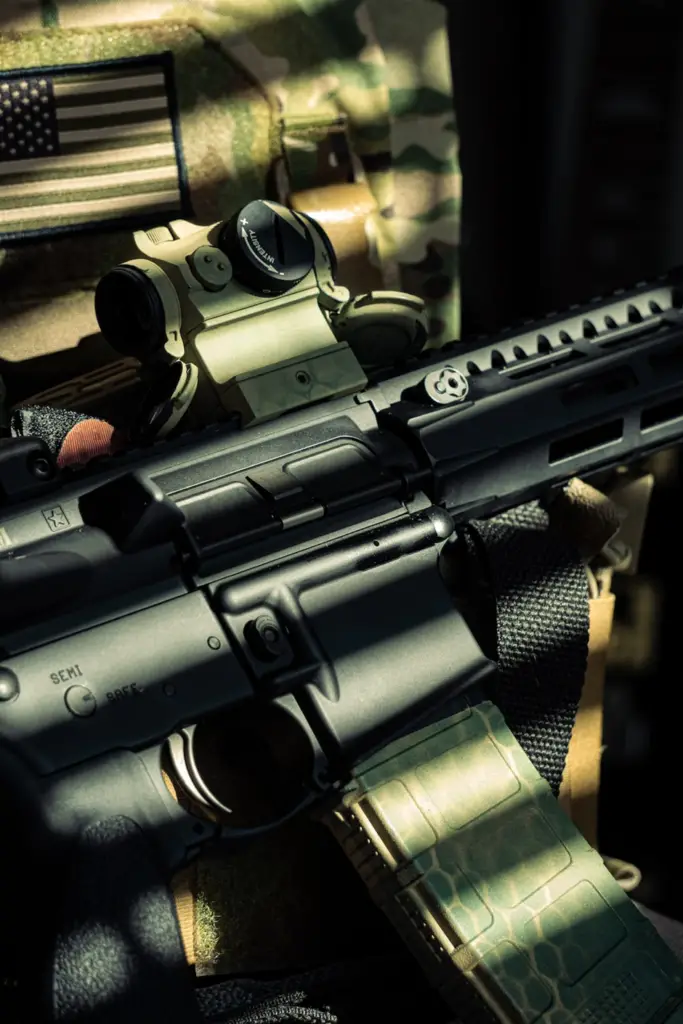Anyone who has shot firearms at the range knows it’s a fun time. Usually, when people go to the range they are testing out a new firearm, adjusting sights, working on proper stances, aiming, reloading, accuracy, or testing out ammunition.
This is all business as usual…but at some point, that time comes when we all pull the trigger as fast as possible and just send a lot of lead down range. Why? Mainly, because it’s fun.
Traditional triggers can be a limiting factor, though. That changed in 2018 when the binary trigger came onto the scene and sped things up.
This of course begs several questions, but here are the main two:
- What are binary triggers?
- Are binary triggers legal?
Answering those questions is the aim of this article.
SKIP AHEAD
What Is A Binary Trigger?
To better understand a binary trigger, let’s go over a few definitions first:
What Is A Semi-Automatic Weapon?
A semi-automatic weapon, which is what most gun owners have, fires one round with a single pull of the trigger. The trigger must be released and reset before it can be pulled again and another single round can be fired.
Without proper and continuous training, a semi-automatic firearm has a relatively slow rate of fire because it relies on the reflexes of the user.
What Are Machine Guns?
On the other end of the spectrum, you have machine guns. Unlike traditional triggers on a semi-auto firearm, a machine gun – or fully automatic firearm – allows multiple rounds or a continuous stream of rounds to be fired when the trigger is pulled or depressed once. This gives them a high rate of fire.
Below is the official definition of machine guns by the ATF (Bureau of Alcohol Tobacco and Firearms).
“…Any weapon which shoots, is designed to shoot, or can be readily restored to shoot, automatically more than one shot without manual reloading, by a single function of the trigger.”
Binary Triggers
When a binary trigger is installed on a handgun or other semi-automatic weapon, it sort of meets in the middle of the two above categories.
A binary trigger is a modification that can be made to a firearm that increases the rate of fire. Unlike a standard semi-automatic trigger, a binary trigger fires one round when the trigger is depressed and when the trigger is released. So, instead of firing one round per trigger pull and release, it fires two.
The binary firing system can be set to either fire in binary mode, as explained in the above statement, or reverted to semi-auto.
Also, there is a safety feature on a binary firing system so that if you don’t want to fire a second shot after pulling the trigger, the safety can be engaged before releasing the trigger and the second shot will not be fired.
How Long Has The Binary Trigger Been Around?
The first binary firing system was created back in 2015 by Franklin Armory, a Nevada-based manufacturer of sporting, military, and law enforcement firearms. Since then, other manufacturers have hopped on the bandwagon and created their own versions.
Are Binary Triggers Legal?
The short answer is yes, at the time this article was written, binary triggers are legal at the federal level. However, that doesn’t mean they haven’t been banned in some areas. Since the answer to this question is subject to change at any time, we highly suggest you check your local and state laws to see if binary triggers are legal where you live.
FAQs
Does a binary trigger turn a firearm into a machine gun?
No. A machine gun fires multiple rounds per one pull of the trigger. A binary trigger only fires one round per trigger pull and one per release.
What weapons can binary triggers be installed on?
The most common binary trigger weapons include pistols, AR-style platforms, and other semi-automatic rifles.
Is a binary trigger expensive?
The binary firing system can run several hundred dollars plus the cost of installation if you don’t do it yourself making them not-so-cheap alternatives.
Is the binary trigger practical?
Some people will say yes while others will strongly disagree. Binary triggers can certainly be a lot of fun at the gun range, which by itself encourages gun owners to possibly use one, but they may also be helpful for self-defense purposes.
Why are binary triggers and bump stocks talked about together?
Even though stock modifications and binary triggers are two completely different things, modifications such as binary triggers and bump stocks are hot topics because they are often part of a gun control plan. You may also hear the term “assault weapons” used in such discussions.
Unlike traditional triggers, binary triggers operate in such a way that some have questioned their federal legality and think they should be considered illegal.
The main argument is that such tools drastically increase the follow-up of second and subsequent shots. This is partly why the bump stock ban took effect in 2018, and some think binary triggers may have the same fate one day depending on the Bureau of Alcohol Tobacco and Firearms.
Is a binary trigger legal in my state?
The binary design is legal in most states (at least at the time of this article), but not everywhere. To find out if binary triggers are legal in your state, search sites run by the federal government and the state you live in.
What are FRTs?
FRT stands for forced reset triggers. It is a term that was used in an ATF letter to try and describe certain types of triggers to the firearm community.
That letter can be viewed by clicking here.
Wrap Up
Whether you want to install a binary trigger to have more fun at the shooting range, for self-defense, or for whatever reason, they are currently legal in most states. Always check your current local laws to make sure you stay in compliance and avoid any unnecessary hassles.
Thanks for reading and stay prepared.






